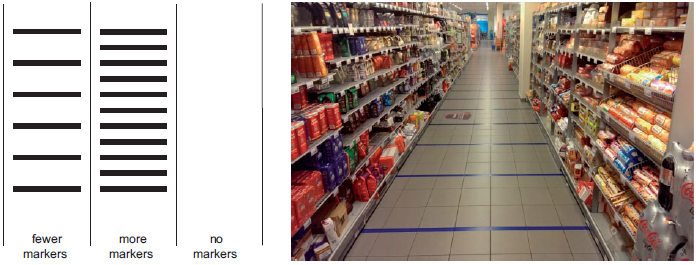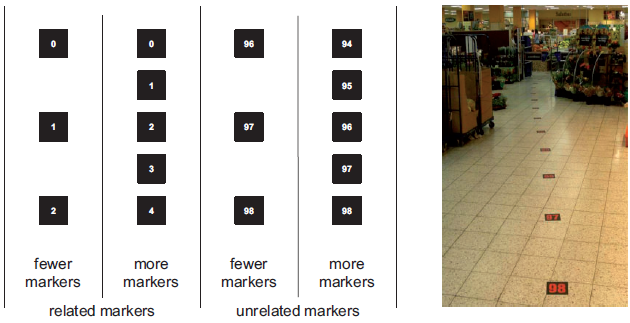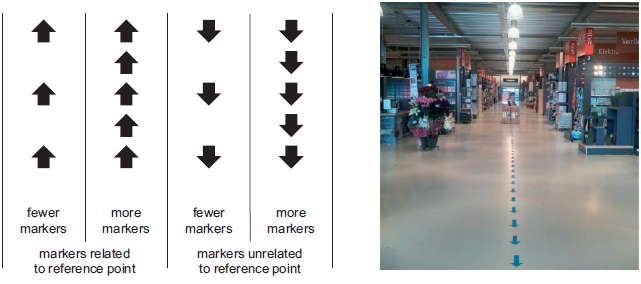We’re not talking about special offers, background music, or the smell of fresh bread. We’re talking about something much simpler – and far less obvious: the floor beneath your feet.
A fascinating study published in the Journal of Consumer Research by Bram Van den Bergh, Nico Heuvinck, Gaby Schellekens, and Iris Vermeir shows that subtle changes to the walking environment can alter how fast people move. And in retail, hospitality, and even workplace settings, that matters more than you might think.
The research set out to answer a question that’s surprisingly underexplored: given that 80% of shoppers’ in-store time is spent walking from place to place, can we manage their pace? It turns out we can – with nothing more than clever use of “progress markers”.
The basics: why speed matters
Pace influences sales, customer satisfaction, and even how likely people are to notice a sign or product. Too slow, and customers may feel crowded or frustrated. Too fast, and they might rush past promotions or fail to browse. Getting the pace right can mean happier customers, more effective marketing, and better flow through a space.
The team drew on a classic psychological principle – the goal gradient hypothesis – which says we get more motivated as we get closer to a goal. Originally tested on rats running towards cheese, the idea applies equally well to humans heading for the till, departure gate, or café counter.
If the goal feels close, we speed up. If it feels far away, we slow down. And here’s where progress markers – lines, shapes, or other visual cues along a path – come in.
Experiment 1: supermarket aisles and university corridors
In their first set of experiments, the researchers added blue lines to supermarket aisles and to a university hallway. The lines could be spaced far apart (fewer markers), close together (more markers), or absent altogether.

The results? People walked significantly faster when there were fewer markers. Psychologically, the longer gaps made the path feel shorter – like the goal was just ahead – triggering that goal-gradient burst of motivation.
But there was a trade-off. In the university setting, the faster pace meant people noticed and remembered less. When the lines were close together, walkers slowed down and were better at recalling posters and objects placed along the way.

So if your aim is to get shoppers to a checkout quickly, fewer markers work. But if you want them to absorb in-store messages or browse, more markers might be your friend.
Experiment 2: when markers don’t matter
Next, the team tested what happens if the markers are unrelated to the destination. For example, in one German retailer, some markers counted down to zero at the entrance (directly tied to the goal), while others displayed numbers leading somewhere beyond or behind the shopper.
When the markers weren’t connected to the destination, the effect disappeared – walking speed stayed the same whether there were more or fewer markers. The brain simply ignored them as irrelevant.

The takeaway here is clear: if you want markers to influence behaviour, they must have a meaningful link to the destination. Otherwise, they’re just decorative floor stickers.
Experiment 3: flipping the effect
Finally, the researchers explored a twist: what if the markers themselves are made more attention-grabbing than the goal?
In one study, they made the floor markers more tactile and noisy by running a wire underneath them so a shopping trolley made a sound when rolling over. In this case, more markers actually increased walking speed. That’s because the markers became the “goal” in the brain’s immediate experience – each one a mini achievement – and a higher rate of passing them felt like faster progress.
So the same physical setup can either slow people down or speed them up depending on what you make most salient: the final destination, or the path itself.
Why this matters for business
This isn’t just an academic curiosity. It’s a toolkit for managing human movement in all sorts of environments:
- Retail – Speed up shoppers in congested areas or slow them near high-margin products.
- Airports – Keep passengers flowing towards gates while encouraging browsing in duty-free.
- Museums & exhibitions – Control dwell times in different zones to balance crowding and engagement.
- Workplaces – Influence movement towards meeting spaces or through security zones without intrusive signage.
And because the interventions involve simple floor designs, they can be implemented cheaply and unobtrusively – no need for constant staff intervention or expensive tech.
The psychology behind it
What’s happening here is all about how we interpret cues in our environment. We’re constantly estimating how far we are from our goals – and we use markers, landmarks, and feedback along the way to judge progress.
- Fewer markers → goal feels closer → faster movement (if the goal is salient).
- More markers → goal feels further → slower movement (but better recall of surroundings).
- Markers unrelated to the goal → no change in speed – they’re mentally filtered out.
- More salient markers than goal → faster movement thanks to “rate of progress” motivation.
Understanding this interplay means you can design spaces that gently steer behaviour without people even realising.
A note on ethics
Any tool that influences behaviour should be used thoughtfully. In some settings – like evacuation routes – speeding people up is clearly beneficial. In others, you’ll want to avoid making visitors feel rushed or manipulated. The art lies in matching the pace to the purpose and making sure the experience still feels positive.
Bringing it back to your business
What the Altering Speed of Locomotion research makes clear is that the tiniest design tweaks can have surprisingly big effects on how people interact with a space. If you can manage the pace of movement, you can shape experiences, increase engagement where you want it, and keep operations running smoothly.
That’s where Adcock Solutions Ltd comes in. We specialise in translating behavioural science insights like these into practical, results-driven strategies for real-world environments. Whether you’re a retailer looking to optimise customer flow, a venue manager aiming to improve visitor satisfaction, or a workplace leader keen to enhance movement and efficiency, we can design solutions that work quietly in the background – so your customers, guests, or staff just feel like everything runs better.
By combining research-backed methods with a deep understanding of your operational goals, we’ll help you create spaces that feel intuitive, engaging, and efficient – all without a single “please speed up” sign.
If you’d like to see how subtle design choices could transform your environment, let’s talk.






